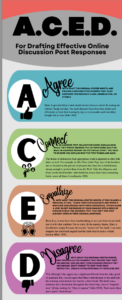If you’ve taken any online classes for your masters or to re-certify, you are familiar with this assignment:
“Please provide a short response to the reading, then respond to at least two peers.”
Discussion forum posts. Ugh. The bane of my online grad school existence. I mean, I understand why instructors use them at the college level, particularly for online classes. You’ve got to have students interact with one another SOMEHOW, and this is the simplest way to make it happen.
But the responses. Oof. I’ll bet THESE look familiar:
“Good point. I agree!”
‘That’s really interesting. Thank you for sharing.”
“I’d never thought about it like that. Thanks.”
These ARE NOT meaning responses to someone else’s post! If you turn in responses like this, you’re looking at a “C” at best. A lot of my students will be doing precisely this type of assignment in Canvas at college, but until a year or so ago, I wasn’t doing any explicit teaching of this skill. Talk about a massive skill gap.
So…I created the ACED model for effective discussion forum posting and taught it to the kids. ACED stands for “Agree, Connect, Empathize, or Disagree.” Those are the four approaches to take when you draft a response to someone’s discussion forum post. I’ve got a snazzy FREE infographic that explains each option and provides an example of what to do.

Please share with your own students. And (potentially) your lame-responding colleagues! Make them save it to their computer’s desktop for quick access.
Keywords: enraged2enagaged, E2E, writing guide, college prep, discussion post tips, writing organizer
Here’s a sharper copy in PDF form!
demoE2EACEDModelInfographicforWritingEffectiveDiscussionPostResponses8752527
